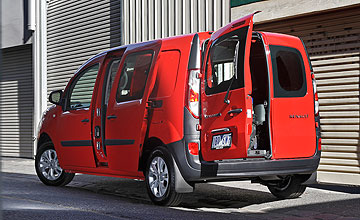BY BYRON MATHIOUDAKIS | 14th Nov 2014

But did you know that it is a light commercial vehicle (LCV) leader in Europe?Now the French company with more than a century’s experience is eyeing off the Volkswagen Caddy’s hard-won light-van market with an extended range of Kangoo LCVs.
And by extended we really do mean stretched, for the L2 Maxi long-wheelbase versions have lobbed along with the established L1 short-wheelbase members when the X61 series underwent a fairly sizeable makeover late last year.
The model that interests us most, however, is the Maxi Crew.
Although the name may suggest a three-row seven-seater model, it is in fact an LCV with five seats and a very utilitarian box space behind the rear backrest.
Sliding doors (albeit with pop-open glazing) and dual barn doors betray the newcomer’s blue-collar origins.
That’s no hardship, though, for what Renault has achieved with the Maxi Crew is remarkable.
For starters, the rear seat is stupendously easy to access via a gaping aperture, while once inside, the cushion is car-like in terms of comfort and space.
It’s not exactly quiet in there due to ever-present road and tyre noise rumbling through from the rear, but it is a very tolerable and surprisingly soft-riding way to get around.
Aiding the journey are big headrests, deep windows that crack open on the sides, ample ventilation and hardy yet attractive cabin trim. Somehow the Kangoo does not feel as cold and Germanic as its VW foe.
Yet if you need this to be a pure two-seater panel van, dropping the rear seats into a deep floor cavity is child’s play, with the resulting cargo capacity vast by anybody’s standards. It’s a clever and appealing solution that really does blur the lines between wagon and workhorse.
Meanwhile, if it wasn’t for the van-like drone at speed on the highway, you might be lulled into thinking you’re driving a high-riding Renault passenger car.
Perched up on lofty seats for a commanding view ahead, the driving position is fine, with a pleasant steering wheel featuring remote controls for the cruise and audio systems, ahead of a clear and very informative set of instrument dials.
Ventilation is easy to access, there’s more storage availability than in some city warehouses and the front seats are fine over long distances.
Better still, the driving experience itself is far more car-like than the Kangoo’s slightly Postman Pat looks suggest.
Under that stubby bonnet is a modern, refined, efficient and powerful iteration of Renault’s excellent 1.5-litre dCi common-rail turbo-diesel, partnered up to a smooth-shifting six-speed manual gearbox.
After an initial hesitation, acceleration is lively even when loaded with four people and 100kg worth of cargo, with the performance coming on continuously and in a steady stream well past the legal freeway speed limit.
Mercifully, there is very little in terms of engine noise or vibration to remind the Kangoo’s occupants that they are in a diesel-powered van.
Additionally, while there is no escaping the soft suspension, the steering is direct and reactive and the suspension feels well planted, for accurate and confident cornering capabilities.
Push on harder and the Renault will settle into a cushy yet controlled rhythm that is typical of older-school French passenger cars but highly irregular if all you are used to are hard-riding vans.
Throw in the Kangoo’s friendly face, and you can see how easy it is to connect to the Maxi Crew as an off-beat alternative to an SUV or medium-sized wagon.
It might not be quite as quiet or refined as the latter, but as a dual-purpose people-carrying van, the Renault comes across as a far more comfortable and inviting proposition than most LCV alternative.
We’re smitten, and we can see why so many Europeans are too.